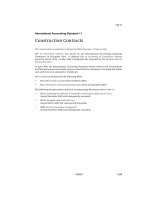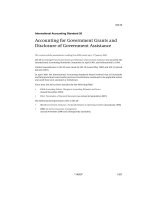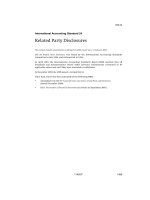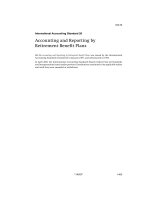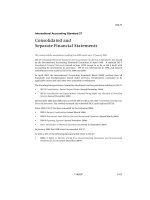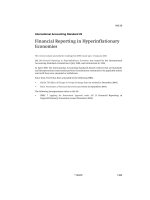chuẩn mực kế toán quốc tế ias 7
Bạn đang xem bản rút gọn của tài liệu. Xem và tải ngay bản đầy đủ của tài liệu tại đây (60.23 KB, 3 trang )
IAS 7
Case Study 1
Facts
XYZ Inc., as part of its cash management activities, invested $10 million in redeemable preference shares
(within three months from the date of their redemption). To do so, XYZ instructed its bank to use a
maturing time deposit (a two-month fixed deposit) with the bank.
Required
Determine how XYZ Inc. would treat in its cash flow statement the cash outflows resulting from the in-
vestment of funds in redeemable preferred shares and the cash inflows resulting from the withdrawal of
funds from the bank by using a maturing time deposit.
Case Study 2
Facts
On January 1, 2004, Dramatic Inc. issued convertible bonds with conversion to take place on or before
the expiry of two years from the date of issuance of the debt. On December 15, 2005, the board of di-
rectors of Dramatic Inc. decided to convert the bonds at year-end and issue equity shares.
Required
How would Dramatic Inc. treat this transaction in its cash flow preparation?
Case Study 3
Facts
XYZ Inc. is preparing its cash flow statement under the direct method and has provided this information:
Net credit sales $5,000,000
Accounts receivable, end of the year 1,500,000
Accounts receivable, beginning of the year 2,500,000
Purchases (on account) 4,000,000
Trade payable, end of the year 1,900,000
Trade payable, beginning of the year 2,000,000
Operating expenses 3,000,000
Accrued expenses, beginning of the year 500,000
Accrued expenses, end of the year 400,000
Depreciation on property, plant, and equipment 600,000
Required
For the purposes of the cash flow statement under the direct method, you are required to compute the
cash collections from customers, payments to suppliers, and cash paid for operating expenses.
Case Study 4
Facts
Excellent Inc. has provided the following information and requests you to prepare the operating activities
of the cash flow statement under the indirect method:
Net income before taxes $400,000
Depreciation on property, plant, and equipment 200,000
Loss on sale of building 100,000
Interest expense 150,000
Interest payable, beginning of the year 100,000
Interest payable, end of the year 50,000
Income taxes paid 100,000
Accounts receivable, beginning of the year 500,000
Accounts receivable, end of the year 850,000
Inventory, beginning of the year 500,000
1
Inventory, end of the year 400,000
Accounts payable, beginning of the year 200,000
Accounts payable, end of the year 500,000
Required
Please prepare the operating activities section of the cash flow statement using the indirect method.
MULTIPLE-CHOICE QUESTIONS
1. An entity purchases a building and the seller accepts payment partly in equity shares and partly in
debentures of the entity. This transaction should be treated in the cash flow statement as follows:
(a) The purchase of the building should be in-vesting cash outflow and the issuance of shares and the
debentures financing cash outflows.
(b) The purchase of the building should be in-vesting cash outflow and the issuance of de-bentures
financing cash outflows while the issuance of shares investing cash outflow.
(c) This does not belong in a cash flow state-ment and should be disclosed only in the
footnotes to the financial statements.
(d) Ignore the transaction totally since it is a noncash transaction. No mention is required
in either the cash flow statement or any-where else in the financial statements.
2. An entity (other than a financial institution) re-ceives dividends from its investment in shares. How
should it disclose the dividends received in the cash flow statement prepared under IAS 7?
(a) Operating cash inflow.
(b) Either as operating cash inflow or as invest-ing cash inflow.
(c) Either as operating cash inflow or as financ-ing cash inflow.
(d) As an adjustment in the “operating activi-ties” section of the cash flow because it is included in the
net income for the year and as a cash inflow in the “financing activities”
section of the cash flow statement.
3. How should gain on sale of an office building owned by the entity be presented in a cash flow
statement?
(a) As an inflow in the investing activities sec-tion of the cash flow because it pertains to a
long-term asset.
(b) As an inflow in the “financing activities” section of the cash flow statement because
the building was constructed with a long-term loan from a bank that needs to be re-paid from the sale
proceeds.
(c) As an adjustment to the net income in the “operating activities” section of the cash
flow statement prepared under the indirect method.
(d) Added to the sale proceeds and presented in the “investing activities” section of the cash
flow statement.
4. How should an unrealized gain on foreign cur-rency translation be presented in a cash flow state-ment?
(a) As an inflow in the “financing activities” section of the cash flow statement because it
arises from a foreign currency translation.
(b) It should be ignored for the purposes of the cash flow statement as it is an unrealized
gain.
(c) It should be ignored for the purposes of the cash flow statement as it is an unrealized
gain but it should be disclosed in the foot-notes to the financial statements by way of
abundant precaution.
(d) As an adjustment to the net income in the “operating activities” section of the state-ment of cash
flows.
2
5. How should repayment of a long-term loan com-prising repayment of the principal amount and interest
due to date on the loan be treated in a cash flow statement?
(a) The repayment of the principal portion of the loan is a cash flow belonging in the “in-vesting
activities” section; the interest pay-ment belongs either in the “operating activi-ties” section or the
“financing activities” section.
(b) The repayment of the principal portion of the loan is a cash flow belonging in the “in-vesting
activities” section; the interest pay-ment belongs either in the “operating activi-ties” section or the
“investing activities” section.
(c) The repayment of the principal portion of the loan is a cash flow belonging in the “in-vesting
activities” section; the interest pay-ment belongs in the “operating activities” section (because IAS 7 does
not permit any alternatives in case of interest payments).
(d) The repayment of the principal portion of the loan is a cash flow belonging in the “in-vesting
activities” section; the interest pay-ment should be netted against interest re-ceived on bank deposits, and
the net amount of interest should be disclosed in the “oper-ating activities” section.
3

